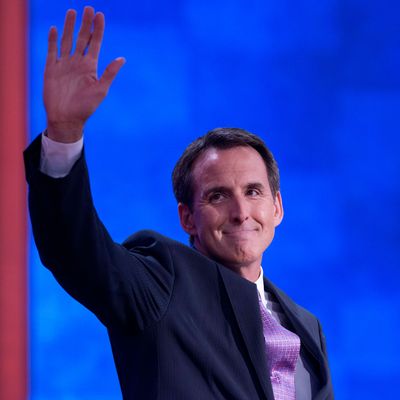
It’s hard to think of anyone in recent national politics who has shown such sporadic promise, with so few results, as former Minnesota governor Tim Pawlenty. He first rose to national attention as the unlikely muse of the intellectual band of “Reform Conservatives” who saw Pawlenty’s call for a Republican Party that represents members of “Sam’s Club, not just the country club” as a good slogan for their effort to reshape the GOP into an instrument for better representing its actual white working-class base. In 2008, in the middle of his second term as governor, he looked like a lock to become John McCain’s running mate, until McCain’s pollster told him TPaw didn’t move the needle at all with persuadable voters, leading the nominee to instead lurch toward “high-risk, high-reward” Sarah Palin.
Having decided against a third gubernatorial term in 2010, Pawlenty decided to go for the brass ring of the presidency himself in the 2012 cycle. He entered the GOP nomination contest looking like someone who was perfectly positioned: uniquely and equally acceptable to the party’s Establishment, tea party, and conservative Evangelical factions, and benefiting from his state’s close proximity to Iowa, where the search for a “conservative alternative to Mitt Romney” would dominate the caucuses. He even had a strategy for offsetting the narcolepsy he so frequently inspired in listeners: his people crafted video ads in which his flat recitation of bromides was matched with over-the-top visuals that at the time I described as “part Transformers, part Triumph of the Will“:
A prominent Reformicon told me in an email early in the cycle that he thought Pawlenty would win because “charisma is overrated.” But his inability to inspire voters (Walter Shapiro said of an early New Hampshire appearance: “Pawlenty’s 13-minute stump speech appeared to reinforce the notion that he is as exciting as ice fishing”) continued to dog him. His once-promising campaign crashed and burned at Iowa’s 2011 Ames straw poll, where he suffered the additional ignominy of losing to fellow-Minnesotan Michele Bachmann, an extremist back-bencher in the state legislature when Pawlenty was governor.
But Pawlenty had a chance for redemption in 2012 when he was again the front-runner for the second spot on the national ticket — before he was again passed over at the last minute for someone more exciting, Paul Ryan.
It’s no surprise that after all that disappointment (and a Romney loss that took a Cabinet gig off the table) Pawlenty decided to cash out and become a D.C.-based bank lobbyist.
TPaw popped back up in 2016 as a backer of Senator Marco Rubio’s presidential candidacy, and went on to support Trump before the Access Hollywood video came out in October. Pawlenty was hardly the only Republican to take a stand at that point, but he did use words that went beyond the minimum necessary to register dismay:
[Trump] is unsound, uninformed, unhinged and unfit to be President of the United States, and I am withdrawing my support of him.
It sure looked like Pawlenty’s bad timing had thwarted any future ambitions yet again. But thanks to the self-launched lightning bolt that struck Senator Al Franken’s career late last year, creating a rare two-Senate-seat election in Minnesota for this November, Republicans began clamoring for TPaw to come out of retirement and challenge appointed senator Tina Smith. He was, after all, by contemporary standards a mere slip of a boy at 57, and had won twice statewide.
Perhaps Pawlenty has finally absorbed the lesson of the Peter Principle, the theory that in every organization or profession people tend to rise to their level of incompetence. In any event, he passed up a Senate race and instead announced today for a campaign he’s already run, for a job he’s already performed: governor of Minnesota. His announcement was via a web video that’s a lot less Triumph of the Will and a lot more Sam’s Club Republican:
Pawlenty can’t be considered a clear favorite to win at this point. Three formidable members of the Democratic Farmer-Labor Party (the state’s Democratic affiliate) are already in the field. And he didn’t win a majority in either of his gubernatorial victories. There’s no particular reason, moreover, to doubt that the midterm adversity that almost always afflicts candidates of the party controlling the White House will somehow miss Minnesota this year.
Still, the Republican trend that pulled nearby states like Iowa and Wisconsin into the Trump column in 2016 hasn’t missed Minnesota, either. Trump’s losing margin in the state was smaller than that of any GOP presidential candidate since Ronald Reagan’s near-miss in 1984.
If the race turns out to be one of those turnout-driven midterm barnburners, it could again be a problem that Pawlenty’s not the kind of pol who is adept at whipping partisans into a frenzy. But for Minnesota Republicans, he’ll have to do.






























